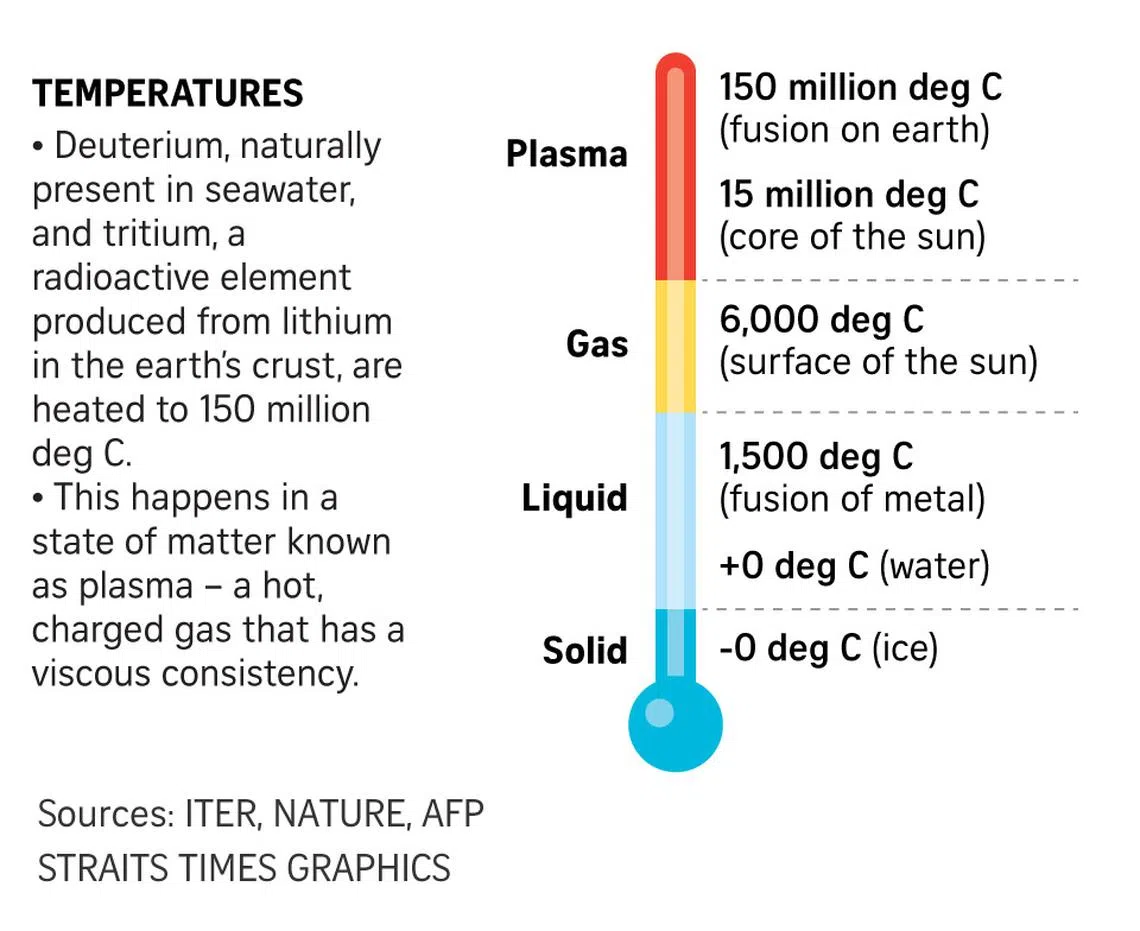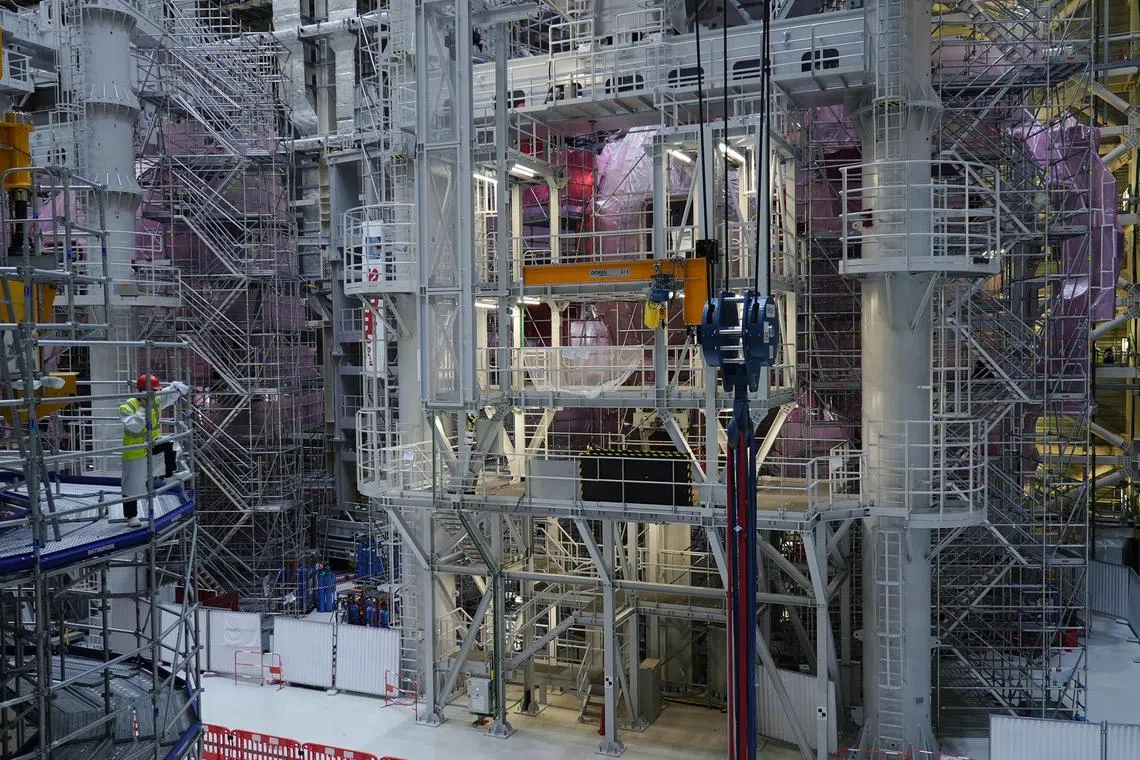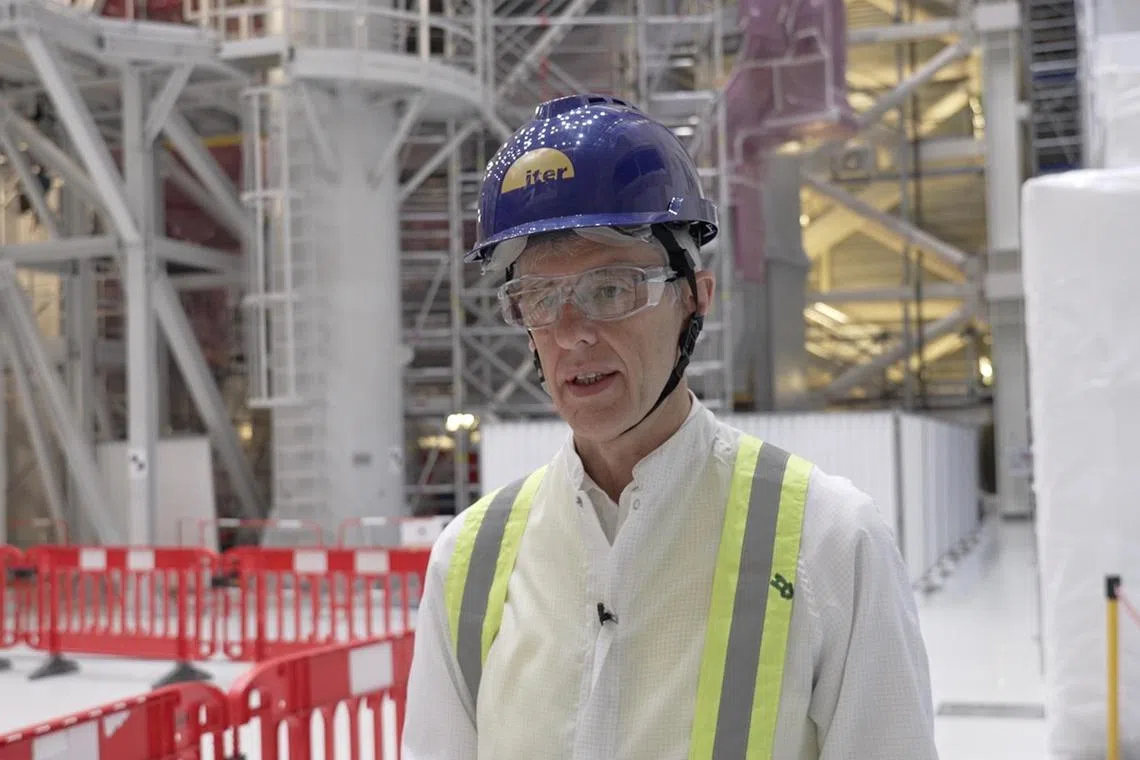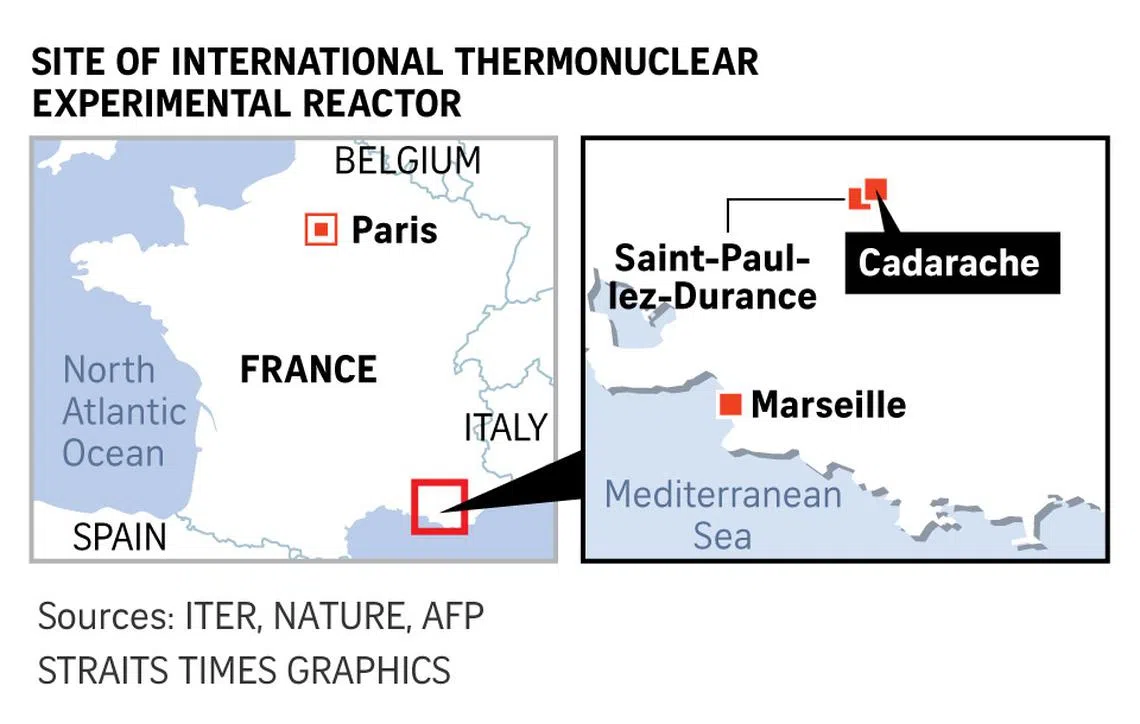Science journals: Nuclear fusion and the promise and challenges of making energy like the sun
Sign up now: Get ST's newsletters delivered to your inbox

The Iter project is a multi-nation effort to demonstrate the feasibility of nuclear fusion, creating a machine that generates electricity the same way the sun does.
ST PHOTO: AZIM AZMAN
Follow topic:
ST-PAUL-LEZ-DURANCE, France - Stepping onto the construction site of the Iter facility, soon to be the world’s largest experimental nuclear fusion project, is like walking into a world of science fiction.
From supersized magnets that reach heights of over 20m, to the massive scaffolding and immense slabs of concrete, the 180ha site, about the size of 250 football fields, in the south of France is home to a dizzying array of complex engineering work.
This is a project that promises the sun.
Nuclear fusion has been touted as the Holy Grail for clean energy, producing immense amounts of energy with no long-term radioactive waste, a problem associated with conventional nuclear plants, where a uranium atom is split in two to generate power.
However, the effort to harness nuclear fusion energy is fraught with technical challenges, including how heat from the reaction can be harnessed economically so it can be used to generate electricity.
Experts say nuclear fusion plants would take decades to become commercially viable, but various research groups, such as those at Iter, are pressing ahead.
By recreating the way in which the sun – a sphere of hot plasma – generates heat and light, nuclear fusion plants essentially replicate the same conditions that allow two forms of hydrogen to fuse.
Short for the International Thermonuclear Experimental Reactor, Iter was built to test a long-held dream of determining whether nuclear fusion, a process that does not release any planet-warming emissions as by-products, can be harnessed as an energy source and eventually generate power at a commercial scale.
It is one of 130 such experimental reactors worldwide – both public and private ones – that aim to see if recreating the processes in the sun can power the world into a future weaned off fossil fuels.
Experimental energy
Fusion reactions happen at extreme temperatures of 150 million deg C, 10 times hotter than the sun’s core, and occur in a state of matter known as plasma – a hot, charged gas, with a viscous consistency.
Within fusion reactors, massive magnets help to control the flow of the swirling plasma, which moves in a circular loop, and prevent the gas from touching the walls of the chamber.
Scientists have been able to prove that fusion reactions work, but the challenge lies in getting the reaction to last for a prolonged period, and, eventually, be self-sustaining – a prerequisite for commercial fusion plants to generate a stable supply of electricity.

It would also be important for these plants to produce more energy than they consume, which smaller fusion experiments have not yet been able to do.
Iter was first conceptualised in 1985 at the tail end of the Cold War, involving countries in the European Union, the US, Russia, China, India, South Korea and Japan.
Its aim was to develop fusion energy for peaceful purposes, through international collaboration.

The assembly floor at Iter, where workers will assemble parts of the tokamak reactor where the fusion reaction takes place.
ST PHOTO: AZIM AZMAN
But it is now facing delays – caused by manufacturing issues, the Covid-19 pandemic and subsequent supply chain disruptions – which could push back the realisation of sustained electricity generation from fusion.
In July, Iter’s director-general Pietro Barabaschi said in a press conference that the facility’s giant fusion reactor will not be turned on until 2034 – nine years later than initially scheduled.
Full operations of the flagship project will be shifted to start by 2039 instead of the initial 2035, said Mr Barabaschi.
This would add an additional €5 billion (S$7 billion) to the project’s cost – which has been estimated to total an eye-watering €20 billion thus far.
In total, more than 30 countries have been involved in manufacturing over a million components, based on their individual interest and expertise.

Then, there were technical challenges.
Some components had quality issues, due to manufacturing faults, while repair works were needed due to welding defects.
Then, there is the challenge of piecing together the various components of the tokamak reactor – the doughnut-shaped chamber – where the fusion reaction takes place.
“Imagine the slices of a clementine,” I was told during a guided visit to the facility in July.

Dr Michael Walsh, Iter’s head of diagnostics.
ST PHOTO: AZIM AZMAN
Each “slice” is assembled by combining two D-shaped magnets, a thermal shield, which prevents heat from escaping the reactor, and various other components.
Slice by slice, the tokamak is then pieced together.
As at July, three out of a total of eight “slices” have already been assembled.
Dr Michael Walsh, Iter’s head of diagnostics, said then that each “slice” weighs more than 1,200 tonnes – the equivalent of four fully loaded Boeing 747 planes – and requires just as much precision in its handling.

A global fusion race
Iter’s construction delays have not dampened enthusiasm for nuclear fusion.
Other countries have also joined the race to develop a viable fusion power plant that can generate commercial-scale electricity.
For example, Britain, which left the Iter project following Brexit, started its own Spherical Tokamak for Energy Production programme – an innovative, smaller and potentially cheaper alternative to the classic tokamak reactor. The programme aims to generate electricity in the 2040s.
The UK Atomic Energy Authority’s chief executive officer Ian Chapman told The Straits Times during a visit to Singapore that the project would be drawing on important lessons from Iter – including its mistakes, and its “glowing successes”, such as being able to build the large superconducting magnets, which serve their purpose well.

The Iter was built to test a long-held dream of determining whether nuclear fusion can be harnessed as an energy source and eventually generate power at a commercial scale.
ST PHOTO: AZIM AZMAN
Iter, being experimental in nature, will not be producing electricity, but will instead produce a significant amount of heat in the range of 500MW for about seven to 10 minutes each time.
This will be 10 times more heat than initially needed to kick-start the fusion reaction.
Its planned successor, also known as the EU’s Demo plant, will draw on Iter’s successes to begin producing electricity, likely some time in the 2050s.
But other countries like China and Germany, too, have kick-started their own fusion mega projects, with commercial operations to begin from around 2040 to 2050.

Private sector cashing in
An influx of private investments has also been channelled towards fusion start-ups in recent years.
This raises the question of whether Iter’s research would still be relevant when it begins operations in about a decade.
There are currently more than 50 fusion start-ups globally, and according to the American non-profit Fusion Industry Association’s 2024 report, the fusion industry has received US$7.1 billion (S$9.3 billion) in funding to date.
But Mr Barabaschi said private sector involvement would not displace Iter’s role in nuclear fusion research. Instead, businesses can help to bring innovation and new ideas to the fusion space.
“We should do our best to help as much as possible, not just the private sector companies, but the larger fusion community in the world, to achieve their objectives,” he said.

Mr Pietro Barabaschi, director-general of Iter, said private sector involvement would not displace Iter’s role in nuclear fusion research.
ST PHOTO: AZIM AZMAN
Iter has since begun engagements with the private sector, to enable more knowledge sharing and open pathways for collaboration.
For example, it organised an inaugural workshop in May, involving some 350 participants, many of whom were from the start-up community, said Mr Barabaschi.
But given the nascency of fusion technologies, it is unlikely that fusion power plants will play a huge role in helping the world to get to net-zero emissions by 2050 – a crucial target that would help limit global warming to 1.5 deg C above pre-industrial levels.
To do that, countries should rely on tried-and-tested technology, be it renewable power like solar and wind, or conventional nuclear fission technology.
Nevertheless, by continuing research and development in the fusion space in tandem, countries would then have cleaner alternatives for the future that would continue to power the world in a more sustainable way from mid-century and beyond.



